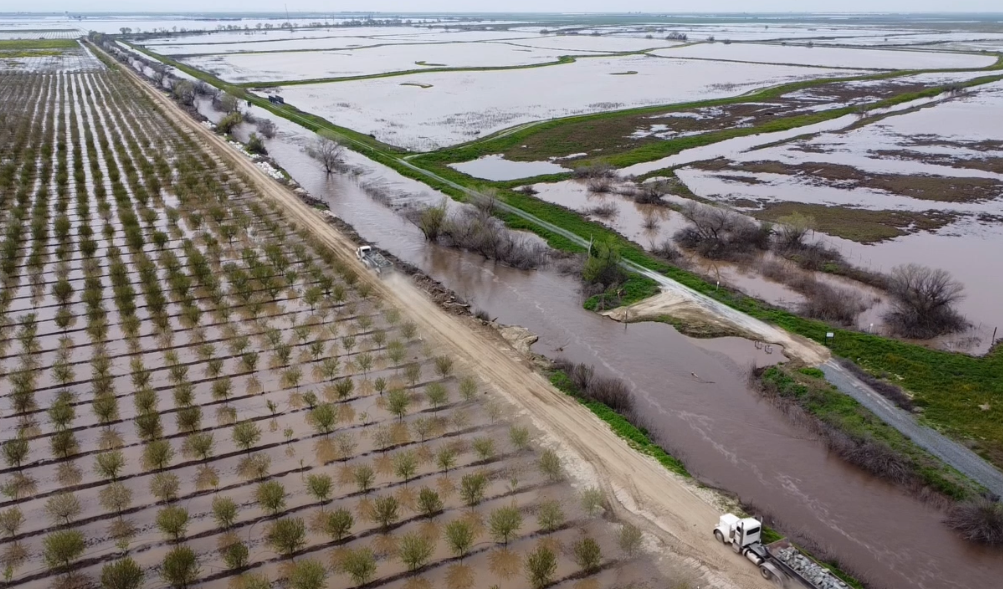When farmers fallowed thousands of acres during the recent drought, most didn’t expect they would be flooding those lands months later. But that’s what happened during last year’s historic floods after the state adapted LandFlex, a drought program, to take on some of the deluge from valley rivers.
“Our original intent with fallow land was for those farmers to put cover crops on it to mitigate dust,” said Teji Sandhu, integrated watershed management program policy advisor for the state Department of Water Resources. “In order to protect communities and cities down south of the rivers, we thought, ‘Why not allow these guys to recharge that land and be able to pull flood waters off onto that fallow land?’”
LandFlex is a program born out of the last drought as a means to take pressure off of declining aquifers near vulnerable communities in the valley. The program had a budget of $25 million and paid local farmers to fallow land, not grow crops, and commit to not overpumping groundwater for all enrolled acres.
The money flows to local groundwater sustainability agencies (GSAs,) which are responsible for reining in groundwater pumping to reach sustainability.
More than 4,300 acres were fallowed in Madera, Fresno, Kings and Tulare counties through LandFlex including:
- 423 acres in the Greater Kaweah GSA
- 577 acres in the Eastern Tule GSA
- 1,642 acres in the Lower Tule GSA
- 616 acres in the Pixley GSA
- 983 acres in the Westlands Water District GSA
- 77 acres in the Madera County GSA
LandFlex paid farmers $1,000 per acre foot of water that they didn’t pump, up to two acre feet per acre of land. The money from LandFlex is a one time payment.
A range of crops were taken out of production including, almonds, walnuts, cotton, corn and wheat.
Farmers paid through LandFlex are now locked into their region’s “sustainable yield,” the amount that can be pumped without declining aquifer levels. Meaning they can’t return to pumping what they had been using prior to enrolling in LandFlex.
Most GSAs are ramping down amounts farmers are allowed to pump and are supposed to reach sustainable levels by 2040.
The 2040 deadline is set by the state’s Sustainable Groundwater Management Act (SGMA) which created the GSAs and aims to bring declining groundwater levels back into balance.
“We fast forwarded from 2023 to 2040 overnight with LandFlex,” said Anja Raudabaugh, CEO of Western United Dairies. “Compliance has not been a popular conversation in certain circles. So having a tool that can motivate people to be compliant with SGMA overnight, I think is really a testament to all the folks working on this.”
About 95% of land enrolled in LandFlex ended up taking on flood water, said Sandhu.
Even though the flooding took place before the first phase of formal fallowing began, the land had already been selected for fallowing through the program. Farmers then chose to take on flood water instead of planting cover crops for those enrolled acres.
For some farmers, the floods helped push them to commit to LandFlex, said Eric Limas, general manager of the Lower Tule and Pixley irrigation districts. Being able to recharge and get groundwater credits for future water budget needs was a factor in their decision, he said.
“Not only did we reduce consumption of groundwater on those lands, because it was a wet year, we were able to flood irrigate and actually recharge on those lands,” said Limas.
Despite the jump to more sustainable pumping levels in some areas, the valley still has a long way to go to reverse its severe overpumping problem. Some estimates say about one million acres of farmland will have to be retired to truly achieve sustainability.
And the decision for landowners, despite the flood benefits, was still not an easy one to make.
“We have a transitional program that allows some overdrafts and it ramps down over time,” said Limas. “They’re giving up that part of the program. So it was difficult for some of them.”
Some landowners had old trees that needed to be pulled out anyway, so money from LandFlex would help that process. Others have been proactive about their water budget and see that they aren’t going to have enough water for their current crops.
For those landowners, generating extra income and gaining groundwater credits made giving up their crops worthwhile, Limas said.
“Everybody looked at it a little differently,” said Limas. “They really had to do some homework and some looking forward, what their operation looks like five, 10, 15 years from now as they made that decision.”
LandFlex will wrap up its current and final fallowing phase in fall of 2024. All of the program’s funds have been used.
Share this:
- Click to share on Facebook (Opens in new window)
- Click to share on Twitter (Opens in new window)
- Click to share on LinkedIn (Opens in new window)
- Click to share on Reddit (Opens in new window)
- Click to share on Tumblr (Opens in new window)
- Click to share on Pinterest (Opens in new window)
- Click to share on Pocket (Opens in new window)
- Click to share on Telegram (Opens in new window)
- Click to share on WhatsApp (Opens in new window)
- Click to print (Opens in new window)








